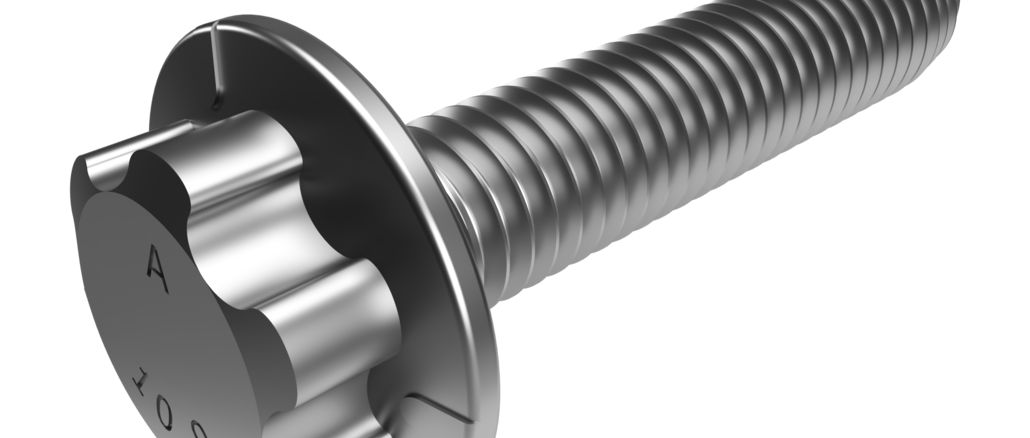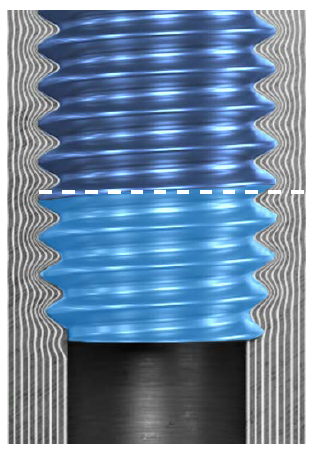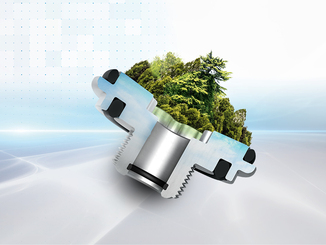
In the case of light metal fittings, the focus is not only on the reliability of the connection but also on installation space optimization as well as performance compression and cost optimization. Against this background, an important point is the load-bearing capacity optimization of the connection.
It is precisely for these applications that Arnold Umformtechnik GmbH & Co. KG has developed Powertite – a round thread-forming screw with a trilobular groove zone. This means that where the forming work is done, the screw has a slightly triangular cross-section (with rounded corners) to reduce the forming moments. With a length of 3 x p (p = thread pitch), the groove zone length is optimized for installation space and enables the forming work during the thread forming process to be distributed over several thread turns as well as optimum screw seating and centering.
The round load-bearing cross-section has a defined oversize; the outer diameter of the screw is always larger than the nominal nominal dimension. This allows a higher overlap of the thread flanks of the screw and the grooved nut thread. The combination of trilobular cross-section in the grooved zone and round cross-section in the load-bearing zone achieves significant optimization of thread-grooved screw connections because, on the one hand, the groove torques are low and, on the other hand, the overtorque and load-bearing capacity of the grooved nut thread are significantly increased.
A mathematical prediction for the specific application is possible with the Arnold tool Fast Designer Metals. This is always preceded by a recommendation from Arnold Umformtechnik for a suitable core hole design.

© Arnold Forming Technology
Large savings potentials are possible
There are numerous examples of the use of thread forming Powertite. These are, for example, applications in which the highest preload forces must be realized through overelastic assembly. Powertite is also suitable for assemblies where only a small screw-in depth can be realized and high hole tolerances are required. In addition, weight reduction can be achieved in many cases by reducing screw lengths and weight-optimized screw heads.
Two concrete examples show that even a small screw can be a climate protector with regard to a specific product. For example, the Powertite M7x40 has been used since June 2022 in a load-distributing transmission that is currently still used in conjunction with an internal combustion engine. With 13 bolts per gear unit and a requirement of around six million bolts per year, this gear unit alone results in a weight saving of around 19,400 kg and consequently a CO2 reduction of 33.1 t per year.
The saving is even more significant for an e-motor gear unit in which 33 bolts are used per gear unit. Of the 50,000 vehicles planned per year, 30,000 are expected to be equipped with two e-motor transmission units per car. Extrapolated to all 50,000 vehicles and the necessary 80,000 transmissions, the total requirement is approx. 2.64 million screws per year. The use of Powertite alone can then achieve a weight saving of around 8,519 kg, i.e. a CO2 reduction of 33.1 t per year in the manufacture of these vehicles.
Further development of thread forming technology
According to Arnold Umformtechnik, the thread-forming Powertite achieves a load-bearing capacity increase of the grooved nut thread of more than 20 percent compared to commercially available trilobular screws. This means a number of technical advantages: standard-compliant furrow moments, overelastic assembly even in conically cast core holes in GD-Al, a preload force level analogous to metric bolted connections, and the possibility of larger core hole tolerances to optimize casting processes of light metals. In addition, there is a high level of assembly safety and applicability in steel as well as aluminum and other light metals. In addition, repeat hollow bolting is possible and replacement with metric bolts is possible during servicing.
The focus of Powertite applications is on electromobility. This applies in particular to light metal bolted joints, but also in combination with cast components.


